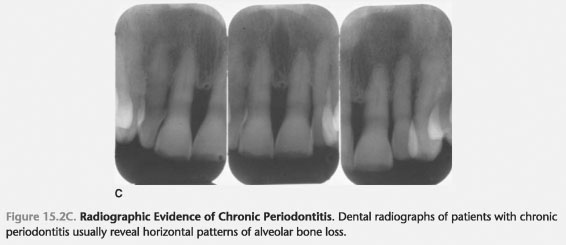Characteristics of Chronic Periodontitis
The most common in people over 35 years of age, but can occur in children and adolescents began and continues plaque, but the response of the host plays an important role in the pathogenesis
Signs and symptoms include swelling, redness, bleeding gums, periodontal pockets, bone loss, tooth mobility, abscesses (pus), a memorial plaque biofilm, Tartar bone loss can be seen on x-ray, the disease progresses slowly and modestly
The application may lose in one area of the tooth investments, several teeth or all of dentition
It can be changed, and other factors, especially Smoking cigarettes



D. loss of investment
1. The volume of the tissue destruction seen in chronic periodontitis corresponds to the amount of plaque biofilm accumulation, local risk factors for systemic risk factors.
2. Clinical attachment loss is the extent that the tooth bearing structures were destroyed around the tooth. The loss of attachment occurs
in periodontal disease and is characterized by: (1) move paroxizmalnaya form epithelium to the root of the tooth, (2) the destruction of fibers Desna,
(3) destruction of the periodontal ligament fibers, and (4) loss of alveolar bone support around the teeth (Fig. 15-3). The changes that occur in the alveolar bone, periodontal disease are significant because the loss of bone height ultimately can lead to tooth loss.
3. Clinical attachment loss of 1 to 2 mm in one or more sites, you can find almost all the members of the adult population.
4. Clinical attachment loss can be classified on the basis of sample clauses supporting structures of the tooth, as measured with a periodontal probe (Fig. 15-4).
a. Soft: a clinical attachment loss = 1 to 2 mm
B. Moderate: clinical attachment loss = 3 to 4 mm
c. Heavy: clinical attachment loss is equal to or exceeds 5 mm
5. Clinical signs of attachment loss may include:
a. Loss of alveolar bone supporting the teeth
B. Periodontal pockets or gingival recession
c. Fork participation in multirooted teeth (Fig. 15-5)
d. Tooth mobility and/or drifting
E. localized or Generalized inflammation
1. Localized inflammation may include one site on a single tooth, several sites on the tooth or several teeth. Generalized inflammation can affect the entire set of teeth.
2. The patient may have and sanitary zones and zones with chronic periodontitis with tissue destruction.
3. Chronic periodontitis is classified as localized, when less than 30% of the sites affected and generalized when more than 30% of the sites affected.

F. Contributing Factors. Chronic periodontitis can be changed and/or associated with the local factors or systemic diseases such as diabetes.
It can be changed, and other factors, especially cigarette Smoking.
C. Symptoms
1. Chronic periodontitis, usually painless. Thus, persons with chronic periodontits can be fully aware of the disease, do not seek treatment, and is unlikely to make treatment recommendations.
2. Individuals may first to realize that there is something wrong, when they notice that their gums bleed when brushing teeth; that the gaps occur between the teeth, or that the teeth became loose.
3. Patients may complain of food impaction, sensitivity to hot or cold because of the open root system, or dull pain radiating to the jaw.
H. chronic Periodontitis in the dental implant tissues. Peri-implantitis the term " chronic periodontitis in the tissue around the implant.
..



